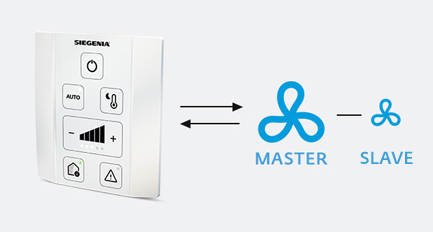Ventilation control sensor
The easy way to operate hard-to-reach ventilators.
The SIEGENIA ventilation control unit enables synchronous control of up to nine ventilation units, making it ideal for large rooms and open-plan living areas. The ventilation control unit impresses not only with its discreet and compact design, but also with its simple installation on walls. When mounting on a wall, we recommend choosing an easily accessible location on the wall. This will mean that even hard-to-reach ventilators – such as those installed close to a lintel or ceiling – are incredibly easy and straightforward to operate.
A range of features – from adjusting the ventilation levels to activating automatic mode or night ventilation – offer even greater convenience. An LED bulb on the ventilation control unit indicates the current air status using the traffic light principle. When necessary, it works in conjunction with automatic mode to automatically regulate the ventilation level required for a healthy indoor environment.
Ventilation is particularly precise in the version with sensors, as well as being demand-based. It is equipped with an integrated temperature and humidity sensor, as well as a CO2 sensor. These two sensors allow the control unit to accurately measure the quality of the indoor air at the precise location where it is installed in the room. This enables precise, reliable values to be measured at all times, even with ventilation units whose location will influence the measurement data – such as those close to a radiator, for example.

Benefits at a glance.
- Control of up to 9 ventilation units
- Status displayed using LEDs, incl. indication of the air quality using the traffic light system
- Integrated temperature, humidity and CO2 sensors
- Simple wall installation
- No additional power supply required
- Wired with a prefabricated SI bus cable
- Dimensions (W x H x D): 100 mm x 109 mm x 23 mm
Compatible ventilation units.
- AEROPLUS WRG wall-mounted ventilator
- AEROMAT VT facade ventilation system, except the AEROMAT VT D version
Control.
The ventilation control unit operates using the master-slave principle. The control unit specifies the mode of operation and air throughput for the master unit. The master unit in turn provides feedback on status, air quality, etc. Up to 8 additional ventilation units can be connected as slave units, which use the same mode of operation and air throughput as the master unit.


Power supply and connection.
Power is supplied via the ventilation unit; there is no need for a separate power supply. Prefabricated SI bus cables in various lengths are available for the connection, which operate using the plug-and-play principle.
The connecting cable comes in a range of different lengths:
It is also possible to purchase an 2 m extension cable if required.
Please note that the number of connection cables required will vary depending on the ventilator and the number of ventilators. For this reason, please also refer to the additional information regarding connection on our Information page.
-
109
-
100
-
23

